



Angela Washko is an artist, writer and facilitator devoted to creating new forums of discussions in spaces most hostile towards feminism. She is a Visiting Assistant Professor at Carnegie Mellon University. Since 2012, Washko has also been facilitating The Council on Gender Sensitivity and Behavioral Awareness in World of Warcraft, her most known project: it’s a series of actions taken within the virtual space of World of Warcraft (“WoW”), an online video game set in a fantasy universe in which people play as orcs, knights and wizards. Her research is focused on the social relations between the gamers, with great attention towards on how these relate with feminism and women, who are becoming more and more numerous between the players of this game. Washko investigates also how design elements of the game influence the relationships of the people who inhabit it; it’s a social study on a community expanding more and more widely, and acts within a limited set of rules designed by video game producers.
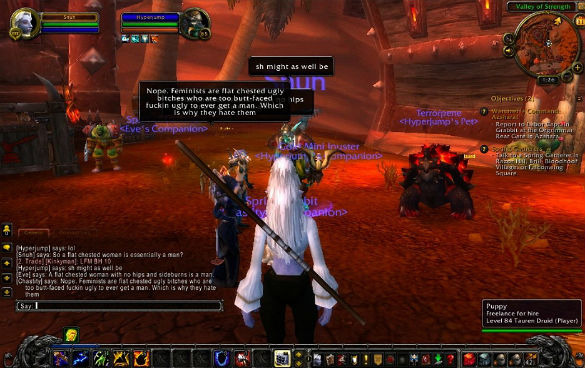
Filippo Lorenzin: I’ve read in some your previous interviews that you started playing WoW in 2006, so we can say you’re a veteran gamer. In the same interviews you pointed out many important elements linking to some of my own research. First of all, the fact you didn’t hesitate to make a parallel between IRL public spaces and online public spaces makes me think you’re part of a generation (as me) that doesn’t care of this division. You create situations and opportunities to let people discuss: it’s as if you meant online gaming as a social activity, rather than a set of rules designed by programmers in which people interact as NPCs (“Non-Player Characters”). What do you think?
Angela Washko: I wouldn’t say that I don’t make a distinction between online and offline space… rather, that these spaces are so integrated and much less separate than the outdated “it’s online/digital therefore it’s not real” model. Online gaming is a very general term and they each have a specific way of operating with contexts that have particular ways of allowing players to communicate to each other. Some of those games are designed to institute high degrees of collaboration in order to get to the most difficult content. World of Warcraft falls into this category. This coercive collaboration breeds a social/chat structure which makes the game as much of a social space as a play space.
My work in WoW is about analyzing the user’s social culture created within the otherwise fantasy oriented landscape and talking to players about the way that it’s developed. So of course there are thousands of things I could have focused on within WoW (and in The World of Warcraft Psychogeographical Association I focus more on exploring the landscape free from quest suggestion/utility and drift about exploring), but for The Council on Gender Sensitivity and Behavioral Awareness in World of Warcraft I was driven to work the way I did due to the treatment of women by the community within the space once players establish their self-identified gender behind the screen. At least on the servers I was playing on.
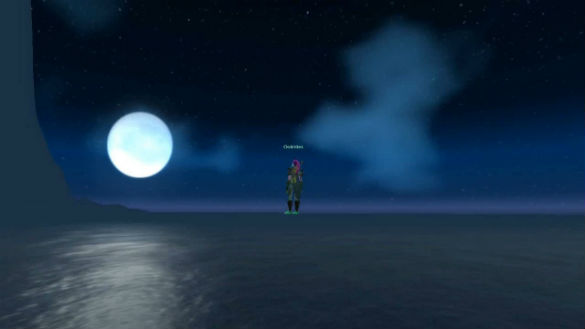
FL: Your use of WoW mechanics in order to raise questions about sexuality and identity makes me think of situationist approaches. As they wanted to create new urbanism refecting the grounded needs and identities of the people, and your actions seem to lead to the creation of a new gaming system, based on players/people who aware of the characteristics of the game and their results in the definition of their identities. Am I wrong?
AW: I guess in WoW I was wondering why the politics of everyday life outside the screen had to govern the rules of this otherwise epic and otherwise not-human-like landscape. I wondered why women were excluded or treated as though they were inherently unskilled (naturally/biologically non-gamers) and at the same time were rewarded for being willing to be abstractly sexualized in guild hierarchies and elsewhere. After being asked to “get back in the kitchen and make [insert player name here] a sandwich” enough times, I stopped playing for a bit. And then I returned, determined to figure out why this was an ubiquitous approach to talking to women in the game space. So I wanted it to be in a place where we could openly discuss and potentially become more considerate about communal language to the point that it could become a much more inclusive space for everyone, and maybe a more diverse social space than we all curate for ourselves in our everyday (physical space) life. Why did our identities outside the screen still have to govern how we are treated as orcs and trolls and whatnot? This game still holds onto a lot of the qualities of the avatar-hidden web 1.0 persona…
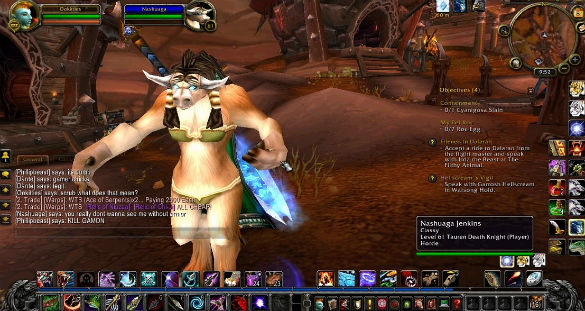
FL: Debord wrote that “the construction of situations begins on the other side of the modern collapse of the idea of the theatre. It is easy to see to what extent the very principle of the theatre – non-intervention – is attached to the alienation of the old world. Inversely, we see how the most valid of revolutionary cultural explorations have sought to break the spectator’s psychological identification with the hero, so as to incite this spectator into activity by provoking his capacities to revolutionize his own life. The situation is thus made to be lived by its constructors.”.
As you can see, it looks like he’s describing your work and I’m really curious to know your opinion.
AW: Well, I have thought about this work (and the psychogeographical work that came slightly later) as definitely linked to Debord and Situationism. I think I became tired of just being able to show the injustices women face everyday. Just prior to the WoW work, I was making videos from replaying single player RPGs from 1992-2003ish showing only women’s storylines and the ways women were represented. I think the work shocked the gallery audiences who saw it because they weren’t gamers and instead of making them think about why the ways in which “women are supposed to act” are embedded in all of our cultural artifacts – it made audiences ask me why anyone would play video games? This frustrated me because I hated the 90s stereotypes that existed about gamers being delinquent and lazy and so I wanted to have conversations in game spaces themselves among the communities that I was involved in rather than just taking from games and then putting them into an art context to be exoticized by art audiences. This is changing a lot as more people identify as gamers and more academics realize the massive amount of people that play games and the cultural importance of games themselves. But I wanted to be able to create a space for discussion with the playerbase itself directly and make that the work rather than making some kind of insightful commentary – to give voice to the community itself to let it speak for itself (regardless of my point of view on the matters discussed) and at the same time try to make sense of how it ended up the way that it did.
FL: The players are being involved in discussions about sexuality and identity. Could you tell your art and cultural references? I can see a lot of ’60s and ’70s approaches…
AW: Oh yes – I mean artists like Valie Export, Adrian Piper, Lynn Hershman, Sophie Calle and the Guerrilla Girls of course, in terms of performance and visibility of women and feminism/feminist activism but in terms of public/media intervention and social practice I think of people like Paper Tiger TV, The Yes Men, The Center for Post Natural History, The Institute for Applied Autonomy, Dara Greenwald, Ant Farm, Kristoffer Orum and Anders Bojen.
I also feel very indebted to remix/appropriation artists like Craig Baldwin who have reclaimed what can be used and how we can rethink existing pop cultural material as sites of intervention for artwork. I also feel like I’m even more influenced by diaristic women writers– particularly Phoebe Gloeckner, Kathleen Blee (sociologist), Elfriede Jelinek, Chris Kraus, Kathy Acker…
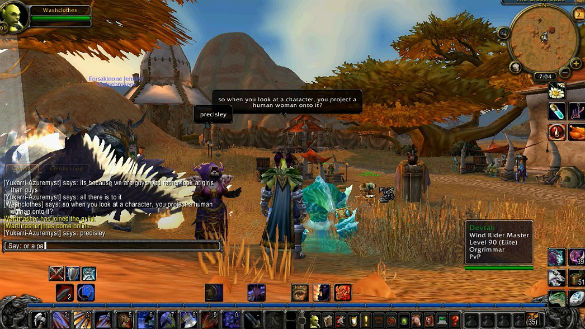
FL: Though question: do you think artists have (or “must have”) a social role? And if they take a stand, what should be their goals?
AW: I think for me interesting artists have a social role! I don’t think that all artists have to make socially engaged work or have to have some kind of service responsibility. I think what was appealing to me about pursuing art as a context for the things I aspire to do is that it is so broad! I mean you have so many “art worlds”, this is a really broad question! So I would say no, but I think artists are in a unique position to have so much flexibility in what you’re permitted to do in your work. In a sociology context, my work would require so much paperwork it would be impossible to get every player I talk to in WoW for my research to sign the necessary papers outside of the game space! So art affords me the flexibility, spontaneity and responsiveness to context to experiment, and really get in there in a way that other fields don’t. So I have found for someone interested in looking at why women are treated the way that they are in fields that are ephemeral and difficult to document, and wanting to have direct discussions about it…art seems to be the field for me to do it in.
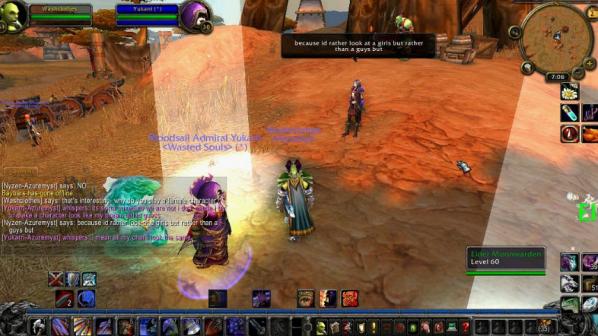
FL: What did you learn from your projects?
AW: Things that I learned which I think will be beneficial for me in the future:
– Be responsible and respectful to everyone you work with.
– Be flexible and responsive. Recalibrate your expectations and be prepared to be wrong about every assumption you’ve already made.
– Think about power. Remember that by being able to capitalize on what you collect, you are in a position of power – make efforts to put yourself in positions of vulnerability. Acknowledge whether or not what you are doing is exploitative. Make everything you do available to all participants who are interested.
– Be clear about what you are doing with the people involved. Be upfront with your participants.
FL: As you previously stated, feminism is a really important element of your research. Did you notice any change between 2010 and now? I’m especially referring to how feminists are portrayed by society, the opportunities in which you can debate and share ideas with somekind of new wave of young artists and critical thinkers who are also deeply involved in these discussions.
AW: When I first started the project, “feminism” was the worst possible word you could say in WoW. Everyone went crazy – feminists were widely described as man-hating whores, flat-chested ugly bitches, women with hairy armpits and worse. But I’ve definitely noticed over time with more mainstream visibility and more writing and a younger generation of artists and celebrities identifying proudly as feminists…the discussions about feminism have become much more complex in WoW and there are many more perspectives and a lot more people self-identifying that way in the space.
Outside of WoW, it seems like more and more women are identifying as feminists and a lot of young writers are really making space for feminism in mainstream media. However, I think it’s been quite polarizing and alienating as well. More and more Men’s Rights Activist groups and nearly militarized manosphere communities are popping up. So with the growth of feminism we also have the growth and visibility of self-identified counter-feminist movements. I think the fact that feminism is a part of mainstream media vocabulary in a way that is a bit more dimensional is definitely positive. The ideas of what a feminist and what a woman can be/do are shifting and evolving and that’s exciting to see.
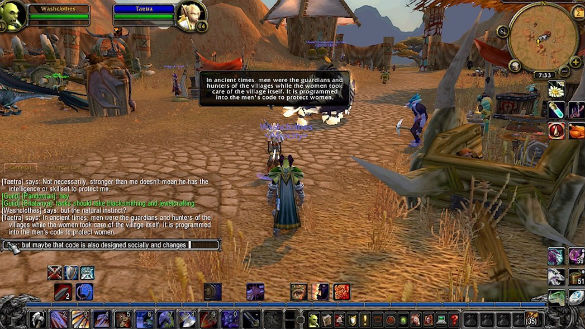
FL: Products like WoW are designed for a masculine audience but looks like it’s not so evident for most of them. With your actions you push other players to discover this aspect, so I wonder if you would define your research as critical art, and or an art that helps others to see the reality behind what the system teaches them).
AW: I would definitely call my work critical art in regard to what you’re proposing! I think in all of my work I am looking at systems and trying to reveal the way they work, using an approach that is accessible to wider audiences than the systems typically reach. I like to approach cultural artifacts by exploring and then dissecting them and then translating/excavating those findings from the site and sharing them as widely as I can.